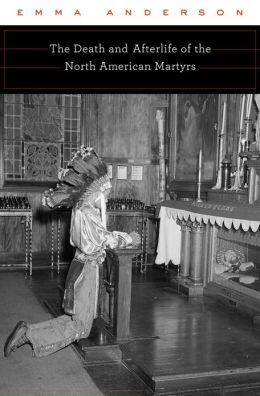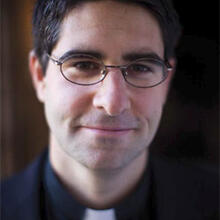Part II of the Discussion (Pages 165-463)
Three hundred and sixty-five years ago this month, Sts. Jean de Brebeuf and Gabriel Lalemant were killed at Taenhatentaron/Saint-Ignace following Iroquois raids on two Wendat villages (Saint Ignace and St. Louis). In 1949, 300 years after their deaths, Fr. Daniel Lord, S.J., directed a pageant or musical spectacular that recalled the events of March 1649 as well as the deaths of the six other North American martyrs. Lord’s production surprised the huge crowd with a second climax. After a calm depiction of the martyrs’ in their eternal repose, the story’s arch-villain, a native medicine man, danced ominously on stage in his native garments. As the music surged to a climax, the medicine man removed his gear. Underneath his indigenous costume, he wore the uniform of a red army soldier (Anderson, 167). The red barbarism of the past had been merged with the red menace of the present. The image was almost seamless, as was the implied response: Canadians were to lay down their lives in the selfless, Christian struggle against Communism like their martyred forebears.
Like Lord’s pageant, Emma Anderson’s book has a second climax. It examines the last 65 years of the martyrs’ afterlife and the modern shrines that preserve their memory and provide a context for their cult. There are several interesting events that spur Anderson’s reflection—the reality of the Cold War; the Quiet Revolution in Quebec; the transfer of half of Brebeuf’s skull from Quebec City to Midland in 1992 (described as an organ donation from a dead shrine to one that might still thrive); the re-internment of the bones of 681 Wendat men, women and children at Ossossane in 1999; and the canonization of Kateri Tekakwitha in 2012. Anderson presents several perspectives in interpreting these events depicted in the second half of the book: French Canadian Jesuits, English speaking Jesuits (Upper Canada Province), native Catholics, native traditionalists, Goan pilgrims at Midland and conservative Catholic pilgrims at Auriesville. Throughout Anderson’s account, several questions from the first half of the text reemerge:
- Are the eight men who were killed in the 1640’s in Canada and Upstate New York legitimately called martyrs?
- Does their cult—in its many forms—exalt the sufferings of eight Europeans who rashly exposed themselves to death in the midst a war among indigenous Americans?
- Does their cult intentionally ignore or disregard the suffering of Wendat Catholics who died alongside the Jesuits simply because they were non-Europeans?
- What of the faceless and nameless native victims of the military raids? What of scores of Wendat Catholics?
- Have the interpretations of the martyrdom of these eight Europeans enabled non-native Canadians and Americans to subjugate indigenous cultures and disabuse them of their patrimony?
- Has the violence absorbed by the North American martyrs been redirected at native Canadians and Americans a hundred fold over the last 365 years—with epidemic and war, with residential schools, reeducation and the disappearance of entire nations of indigenous people?
These are difficult questions to which I will return. But first, Prof. Anderson offers several insights that help one address these questions. The overarching principle by which Anderson’s account proceeds is the “alchemy of martyrdom.” This interpretive metaphor signifies a deception or, at least, an inauthenticity surrounding the sanctity of martyrdom. That is, the North American Martyrs, in the right context and with the appropriate interpretive tools, can become icons of masculinity (rugged outdoorsmen, “square” and manly Canadians, and stoic pioneers); spiritual bulwarks against Communism; representations of Canadian nationalism; underdogs who persisted in their most fundamental and pure beliefs; religious colonizers; or crude, overbearing European chauvinists. Anderson helps the reader understand the implicit connection between ethnic pilgrimages to the Midland shrine and the plight of Eastern European Catholics behind the Iron Curtain. Poles, Slovaks, Hungarians, Lithuanians and Czechs came to the shrine praying for their compatriot co-religionists still suffocating under Communism. Such groups sought the martyrs’ intercession for the overthrow of Communist regimes. Furthermore, conservative Catholics have seen the martyrs as exemplars for Catholics who conform their lives to the teachings of the church in the midst of a culture that dismisses such moral stands. But, Prof. Anderson’s most powerful image revolves around bones.
In her account, Prof. Anderson strips the martyrs to their bare bones. The pious accounts of the deaths of the North American martyrs center upon blood—a Catholic, Eucharistic image that emphasizes the suffering of these men in their ministry. Prof. Anderson’s account concerns the bones—the hard, bare traces of their actions and the cults that revere the calcified remains of the martyrs’ actions in the new world. Various perspectives en-flesh or incarnate the bones of the martyrs as they have seen fit—to uphold the Christian notion that suffering bears fruit. The bones of the martyrs have become sacred remnants of their efforts to evangelize New France, while the bones of Wendat Catholics and other natives have been desecrated through racial bias, archeological investigation and neglect. The bones of native peoples have been en-fleshed with savagery and recalcitrance toward Western values and norms. The martyrs’ cult has served to prize the bones of Europeans over and against the native peoples they served—or, as some in Prof. Anderson’s account would have it, those whom the martyrs hectored and diminished.
Indeed, Prof. Anderson’s account unsettles. Yet, there are many aspects that seem to be missing. What of Pope John Paul II’s visit to Midland in 1984? What about the pope’s and the Jesuits’ deference to native peoples throughout Canada in the last 30 years? (Yes, this does not right the wrongs of how the church treated native peoples in many instances, but the central authority of the church sought, in the person of John Paul, to recognize and emphasize the dignity of the native peoples of North America.) Prof. Anderson only mentions the pope’s visit twice. Surely this was an important moment in the history of the cult of the martyrs? Has there not been a concerted effort on the part of modern Catholics to merge historical consciousness with devotion throughout Catholic intellectual life and scholarship? Perhaps, Prof. Anderson’s account will further spur such an important melding.
Lastly, there is a concern regarding truth. For Prof. Anderson, truth is “inescapably multiple” (305). One view of Christian martyrdom, as she writes, “does not ultimately trump or negate the others. All are important. All are true” (53). I do not think Prof. Anderson actually believes these conclusions. Violence is never true. Overbearing presentations of an overbearing God are not true, and if they are true—then the God to which they point is not True God. The underdog, the martyr, the victim are not exalted but for their authenticity and goodness—their adherence to a truth that enriches life, that attests to a fuller human life. If a concept like martyrdom devolves into alchemy, then the beliefs that underpin the reverence of a particular view of martyrdom are false. The Cross of Christ can become alchemy as well if it upholds violence or bias or abuse. The great truth about Christ—the one in whom the martyrs believed with all their hearts—was that Jesus Christ manifested the love of the Triune God. If service to such truth injures others, then such service was oriented not to Christ, but to something else. The martyrs sought to save the souls of others. If they went about their business to save their own souls, then their efforts will indeed be inefficacious. Piety, authenticity, blood, bone—this is the stuff of an incarnate God.
Prof. Anderson’s account concludes with the question—will the cult of the North American martyrs live on? And so, I ask the readers of Prof. Anderson’s account:
- Will the cult of the North American martyrs endure in future generations?
- Should the cult of the North American martyrs incorporate the native Catholics that died with and around them – like the devotions to St. Paul Miki and companions, the Vietnamese martyrs, the Chinese martyrs, and martyrs of the Spanish Civil War?
- How do you en-flesh the bones of the North American martyrs? How do they become alive to you?









Should the cult of the North Americans incorporate the native Catholic "converts" that died with and around them?
ABSOLUTELY YES! I put "converts" in quotes because it can be no more clearer to me that Wendot/Huron Joseph Chihoawtenhwa was born a Christian. The seed of Christianity was en-grafted, implanted on the soul of Chihoawtenhwa by OUR FATHER HIMSELF. That seed was warmed, nurtured, watered by the Black Robe Jesuits and blossomed into sanctity and martyrdom with the intercession of the Holy Spirit. Chihoawtenhwa pestered the Jesuits for the Sacrament of Baptism. He had foreknowledge of his own physical death by the hands of his own people. He had unique insights into the evil hand of their paganism and turned away from that towards "the brave stretched out nailed to wood" on Saint Bre'breuf's hut. Marie Aonetta is a saint and martyr as is Joseph Chiwatenhwa. Of this I can be not be more certain as I studied this volume, prayed to Saint Joseph Chiwatenhwa in my daily prayers and meditated upon his life in an Ignatian exercise. I pray for the courage he had. Saint Joseph Chiwatenhwa took St. Bre'breuf to the Echon Tree which was the center of his spiritual life prior to conversion and where he spiritually sacramentally bonded in marriage to Marie Aonetta. Saint Bre'breuf immediately recognized Joseph's spirituality embodied in this natural setting and immediately ordered Saint Marie among the Hurons Jesuit Headquarters to be be constructed on that site. The Wendot/Hurons did not call Saint Bre'breuf "Father Bre'breuf". They called him "Echon", after this balm emitting healing tree at the center of the combined Jesuit/Wendot community. It is very disappointing to me that Emma Anderson describes how native peoples are turned away from depictions at Auriesville, preferring to go to Fonda, NY, the town founded by the Henry Fonda acting family. There, is the shrine of Saint Kateri Tekakwitha where native peoples commune with this Saint more in tune with their hybrid spirituality.